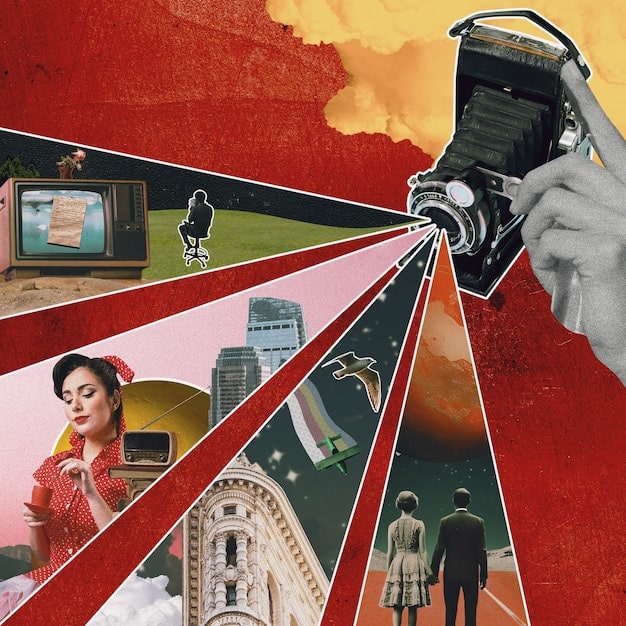Documentary Boom: Exploring the Rise of American Non-Fiction Filmmaking

What’s driving the boom in American documentary filmmaking? Several factors contribute, including increased accessibility through streaming platforms, a growing appetite for real-life stories, innovative storytelling techniques, and the impact of social and political issues on filmmaking trends.
What’s driving the boom in American documentary filmmaking? The question echoes through the halls of independent cinemas and the streaming libraries of millions. It’s a confluence of technological advancements, shifting cultural preferences, and a hunger for authentic narratives that’s fueling this exciting era of non-fiction storytelling.
The Streaming Revolution and Doc Accessibility
Streaming platforms have revolutionized how we consume media, and documentaries have greatly benefited. Gone are the days when documentaries were confined to niche film festivals or late-night public television slots. Netflix, Amazon Prime, Hulu, and HBO Max have all invested heavily in documentary content, making these films readily accessible to a global audience.
Democratization of Distribution
Netflix’s entry into the documentary space was a game-changer. By greenlighting and acquiring documentaries on various topics, they provided filmmakers with a vastly larger audience than was previously imaginable. This has incentivized production and created a more sustainable ecosystem for documentary filmmaking.
Increased Visibility
The high-profile placement of documentaries on these platforms means more people are discovering and engaging with them. Algorithms recommend documentaries to viewers based on their past viewing habits, which further expands the reach of these films.

- Global Reach: Streaming services offer documentaries to audiences worldwide, breaking down geographical barriers.
- Convenience: Viewers can watch documentaries on demand, anytime and anywhere, which contributes to increased consumption.
- Discovery: Streaming algorithms recommend documentaries based on viewing history, exposing viewers to new and diverse stories.
The streaming revolution has not only provided a platform for documentaries but has also changed audience expectations. Viewers are now accustomed to high-quality production values and engaging narratives, creating a demand for well-crafted non-fiction films.
A Growing Appetite for Real-Life Stories
In an era saturated with fictional content, there is a yearning for authenticity and genuine human stories. Documentaries offer a unique opportunity to explore real events, meet real people, and gain insights into different perspectives. This hunger for reality is a key factor driving the documentary boom.
Escapism Through Reality
Paradoxically, documentaries can offer a form of escapism. Instead of immersing themselves in fictional worlds, viewers can engage with complex social issues, historical events, and personal narratives that expand their understanding of the world.
Connecting with Humanity
At their core, documentaries are about people. Whether they focus on political movements, environmental crises, or personal struggles, these films connect viewers with the shared human experience. This empathetic connection is what makes documentaries so compelling.
Documentaries also offer a platform for marginalized voices and underrepresented perspectives. By giving a voice to those who are often unheard, these films contribute to a more inclusive and nuanced understanding of society.
Innovative Storytelling Techniques in Documentaries
Documentary filmmaking has evolved significantly over the years. Filmmakers are now experimenting with new storytelling techniques, blending traditional approaches with innovative methods borrowed from fiction filmmaking. This has resulted in documentaries that are not only informative but also emotionally engaging and visually stunning.
Blending Styles
Many modern documentaries incorporate elements of fiction, such as dramatic reenactments, stylized visuals, and unconventional narrative structures. This blurring of lines between fiction and non-fiction creates a more immersive and compelling viewing experience.
Interactive Storytelling
Some documentaries are pushing the boundaries of traditional filmmaking by incorporating interactive elements. Viewers can participate in the storytelling process through online platforms, offering their own perspectives and contributing to the narrative.
- Visual Aesthetics: High-quality cinematography and editing enhance the viewing experience and draw audiences in.
- Sound Design: Immersive sound design creates a more visceral and emotional connection with the subject matter.
- Narrative Structure: Creative narrative structures keep viewers engaged and enhance the emotional impact of the story.
The use of innovative technologies, such as drones and virtual reality, has also expanded the possibilities for documentary filmmakers. These tools allow filmmakers to capture unique perspectives and create immersive experiences that were previously unimaginable.
The Impact of Social and Political Issues
The documentary boom is also being fueled by a growing awareness of social and political issues. Filmmakers are using documentaries as a powerful tool to shed light on critical topics, spark conversations, and advocate for change. This has resulted in a wave of impactful documentaries that are resonating with audiences worldwide.
Raising Awareness
Documentaries can bring attention to issues that might otherwise be overlooked by mainstream media. By providing in-depth coverage and personal stories, these films can raise awareness and inspire action.

Advocating for Change
Many documentaries are explicitly designed to advocate for social and political change. These films often include calls to action, encouraging viewers to get involved in addressing the issues raised in the film.
However, the use of documentaries for advocacy can also raise ethical considerations. Filmmakers must be mindful of their own biases and strive to present a balanced and nuanced perspective on the issues they are exploring.
Funding and Support for Documentary Filmmakers
The health of the documentary film industry depends on the availability of funding and support for filmmakers. Fortunately, there has been a significant increase in funding opportunities in recent years, thanks to the generosity of foundations, private donors, and government agencies.
Grant Opportunities
Organizations like the Sundance Institute, the MacArthur Foundation, and the National Endowment for the Humanities offer grants to documentary filmmakers. These grants can provide essential funding for production, post-production, and distribution.
Crowdfunding Platforms
Crowdfunding platforms like Kickstarter and Indiegogo have become increasingly popular among documentary filmmakers. These platforms allow filmmakers to raise money from a large number of individual donors, which can be a valuable source of funding, particularly for independent projects.
- Film Festivals: Festivals provide a platform for filmmakers to showcase their work and connect with potential distributors and funders.
- Incubator Programs: These programs offer mentorship and resources to emerging filmmakers, helping them develop their skills and projects.
- Tax Incentives: Many states offer tax incentives to filmmakers who produce their films within their borders, which can significantly reduce production costs.
Despite the increase in funding opportunities, documentary filmmaking remains a challenging profession. Filmmakers must be resourceful and creative in order to secure the funding they need to bring their visions to life.
The Future of American Documentary Filmmaking
The future of American documentary filmmaking looks bright. As technology continues to evolve and audiences become increasingly engaged with real-life stories, documentaries will remain a powerful and influential art form. We can expect to see even more innovative storytelling techniques, diverse perspectives, and impactful films that shed light on the critical issues facing our world.
Immersive Technologies
Virtual reality and augmented reality will likely play an increasingly important role in documentary filmmaking. These technologies allow filmmakers to create immersive experiences that transport viewers to the heart of the story.
Artificial Intelligence (AI)
AI is already being used in documentary filmmaking for tasks such as transcription, translation, and editing. As AI technology advances, we can expect to see even more sophisticated applications, such as automated fact-checking and personalized storytelling.
Ultimately, the future of documentary filmmaking depends on the ability of filmmakers to connect with audiences on an emotional level. By telling compelling stories that resonate with viewers, documentaries can inspire empathy, promote understanding, and drive positive change in the world.
| Key Point | Brief Description |
|---|---|
| 🎬 Streaming Boom | Streaming platforms like Netflix and Amazon Prime provide wider access. |
| 🌟 Real-Life Narratives | Audiences crave authenticity and genuine stories that documentaries offer. |
| 🛠️ Innovative Techniques | Blending fiction and non-fiction elements enhances engagement. |
| 📣 Social Impact | Documentaries raise awareness and advocate for social and political change. |
FAQ
▼
They offer authentic stories that resonate with viewers seeking real-world insights, enhanced by streaming platforms’ accessibility and innovative filmmaking techniques.
▼
Streaming services provide documentaries with larger audiences and increased visibility, making it easier for viewers to discover and watch diverse films.
▼
Documentaries serve as a powerful tool for raising awareness and advocating for change on critical social and political issues, driving conversation and action.
▼
Filmmakers are blending styles, using interactive storytelling, high-quality visuals, and immersive sound design to enhance viewer engagement and emotional impact.
▼
The future includes using virtual reality, augmented reality, and integrating AI for tasks like editing, fact-checking, and personalized storytelling, enhancing viewer experiences.
Conclusion
In conclusion, the boom in American documentary filmmaking is a result of intertwined factors: the streaming revolution, audience’s desire for real stories, innovative techniques and funding opportunities. This surge of creativity and accessibility ensures that documentaries will continue to inform, engage, and inspire audiences for years to come.





